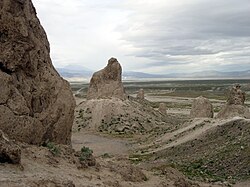Tufa

Tufa (sometimes also known as sinter) is a soft, friable and porous calcite rock. It is acalcium carbonate (CaCO3) deposit that forms by chemical/biological precipitation from bodies of water with a high dissolved calcium content. Calcareous tufa is not to be confused with tuff, a hard volcanic rock that is also sometimes called tufa.
Tufa deposition occurs in seven known ways:
- Mechanical precipitation by wave action against the shore. This form of tufa can be useful for identifying the shoreline of extinct lakes (for example in the Lake Lahontanregion).
- Precipitation from supersaturated hot spring water entering cooler lake water.
- Precipitation in lake bottom sediments which are fed by hot springs from below.
- Precipitation from calcium-bearing spring water flowing into an alkaline lake.
- Precipitation throughout a lake as the lake water evaporates, leaving the lake supersaturated in calcium.
- Through the agency of algae. Microbial influence is often vital to tufa precipitation and may be involved in the other methods listed.
- Precipitation from cold water springs (for example in the foothills of the Rocky Mountains near Hinton, Alberta).
Tufa is common in many parts of the world. There are some prominent towers of tufa at Mono Lake and Trona Pinnacles in California, USA, formed by the fourth method mentioned above whilst submerged and subsequently exposed by falling water levels. Tufa is also common inArmenia and Great Britain.
Practical use
Tufa is today occasionally shaped into a planter. Its porous consistency makes tufa ideal foralpine gardens. A concrete mixture called hypertufa is used for similar purposes.


No comments:
Post a Comment